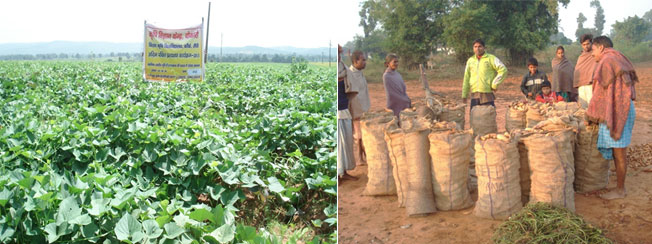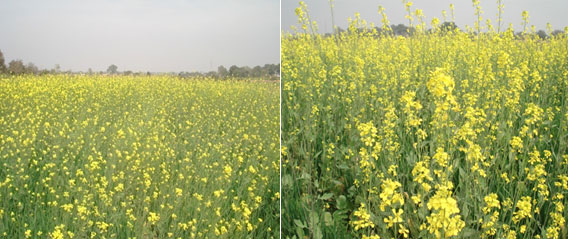Success Stories
Acid Soil Management Through Sweet Potato Cultivation With Nutrient Management
It is estimated that in Jharkhand about 37.9 lakh ha of land have soil PH 5.5 which comprise of about 49% of the total geographical area (TGA) of the state. Where as in Bokaro district about 2 lakh ha lands are strongly acidic PH 5.5 which is about 69.5% of TGA of the district. Soil acidity is limiting factor for crop production particularly for legumes, oilseeds maize, wheat, vegetables and fruits. The problem of acidity is likely to increase due to erosion of surface soil and use of excessive nitrogenous fertilizer by farmers. These soils produce 30 to 50% of their potential capacity. Through proper soil management soil productivity can be improved considerably and yield can be doubled. But liming has not become a common practice with farmers due to non-availability of liming material in local markets.
So in this situation attempt has been made to identity a suitable acid tolerant crop and ensure adequate supply of nutrients to this crop. During our PRA survey in our adopted village of KVK i.e Ambadih and Lepo, we came to know that farmers of these villages are previously growing sweet potato in their upland acidic soils but later on their tuber yield starts decreasing and slowly the area under sweet potato decreases. To know the exact reason for this we had planned on farm trials on sweet potato in 2010-11 & 2011-12, with four treatments viz Farmer’s practice (30 kg N/ha as top dressing), 50% RDF, 50% RDF + lime @ 4q/ha in furrow and 100% RDF. The recommended dose of fertilizer for sweet potato is 50:60:60 (N:P2O5:K2O kg/ha). Average increase in yield in sweet potato was 37% in 50% RDF and 78% in 100% RDF treatments. But the response of lime was not significant (Table 1). The highest tuber yield 17.6t/ha with a net return of Rs. 71,650.00/ha and B:C ratio of 5:42 was observed in 100% RDF treatment where as tuber yield of 13.7 ton/ha with a net return of Rs. 53350.00/ha and B:C ratio of 4.5 was found in 50% RDF treatments.
Table I : Effect of nutrient management on yield of sweet potato.
| Farmers practice (No use nutrients ) | 08 | 9.93 | - | 31.5 | 14200.00 | 49650.00 | 35450.00 | 3.5 |
|---|---|---|---|---|---|---|---|---|
| Technological option i (50 % recommended dose of fertilizer) | 13.71 | 38.0 | 35.0 | 15200.00 | 68550.00 | 53350.00 | 4.5 | |
| Technological option ii(50 % recommended dose of fertilizer + Lime @ 4 qt/ha in furrow application) | 13.81 | 39.0 | 35.1 | 16000.00 | 69050.00 | 53250.00 | 4.31 | |
| Technological option iii ( 100% recommended dose of fertilizer) | 17.57 | 77.0 | 38.5 | 16200.00 | 87850.00 | 71650.00 | 5.42 | |
| CD(P=0.05) | 3.4 | 4.5 |
* Cost of sweet potato tuber is taken as Rs. 5000.00/ton
B.C Ratio= Gross return/ Gross cost of cultivation

So for resource poor farmer 50% RDF (20:30:30 N P2O5: K2Okg/ha) and for resource rich farmer 100% RDF (50:60:60 N:P2O5: K2O kg/ha) is recommended. This technology is also suited in drought/ intermittent drought condition as a contingent crop. The technology has been recommended to ATMA Bokaro for large scale extrapolation. KVK Bokaro has also taken this technology for FLD in farmer’s field in 2012-13 & 2013-14. The technology has been widely adopted by farmer’s of Bokaro and Ramgarh district in upland acidic soil. This year 2013-14, sweet potato has been cultivated in about 200ha area using balanced amount of nutrients in Petarwar, Kasmar block of Bokaro and adjoining Gola block of Ramgarh and they have earned huge profit from their uncultivated acidic upland soils. About 50 truck load of sweet potato had been sent to West Bengal from these villages.

So, for increasing the system productivity of acidic upland this technology has been proving boon for farmer’s as they are getting about Rs. 70,000.00/ha from their most neglected upland barren lands.
Cultivation Of Mustard Brings Happiness
In Jharkhand, the area under oilseed crop was 0.76 lakh ha in 2012-13 with production of 0.35 lakh tons with an average yield of 0.69 t/ha.
It is fourth in area after cereals, pulses and vegetables and occupy only 3 per cent cropped area. Rapeseed- mustard occupies 30 percent of total area and 27 percent of total production of oilseed crops in Jharkhand. Mustard is grown in 1540 ha lands in Bokaro district in partially irrigated condition, but the average productivity is only 5.5q/ha. Lack of improved seeds of high yielding varieties, under dose of fertilizers, insect-pest and disease are the limiting factors for decline in yield.
The Government of India spreads lot of foreign exchange to import edible oil from foreign countries to meet domestic needs of our ever-increasing population. To boost the production potential of rapeseed- mustard, various programmes have been launched by the central government. In the above background Directorate of Rapeseed-Mustard Research (DRMR) Bharatpur, Rajasthan had sponsored a Project with aim to evaluate suitable rapeseed-mustard cultivars to improve tribal farmers growing practices by undertaking capacity building programme in Bokaro district of Jharkhand. The project will ultimately aim at increasing rapeseed-mustard production in the area.
For this Project tribal villages of Petarwar and Kasmar block of Bokaro district were selected. The villages are Petarwar, Rukam, Katarbera, Chargi, Lukiya, Dandubandh, Kojram, Ordana, Etke, Koh, Bundu, Mayapur, Chatugarha in Petarwar block and Karkattakala, Chandipur, Ormo, Bemrotand, Panatanr, Khudibera, in Kasmar block.
On-farm demonstration or Participatory Varietal selection trials were conducted in 30 ha area in different villages in two consecutive years 2011-12 and 2012-13. The demonstration was carried in maize-fallow cropping system in upland condition and rice-fallow cropping system in medium land situation.
Before the start of cropping season 4 nos. of one day on farm training programme on Mustard Production Technology were organized in the year 2011-12 & 2012-13 in Koh, Kojram, Karkattakala and Chargi village. During the cropping season two day on campus training programme from 19th to 20th February 2012 on Mustard Production Technology were organized at BAU Ranchi in which 35 tribal farmers participated. An exposure visit was also organized for these farmers for visiting DRMR, Bharatpur from 08.01.2012 to 15.01.2012 and 12.12.2012 to 14.12.2012.
The results of the on-farm demonstration of 2011-12 are given in table 1 & 2.
Table - 1 : Yield performance of different mustard varieties under demonstration
| Crop | Variety | No. of Farmers | Area (ha.) | Demo. Yield Qtl/ha | Yield of Local Check | Qtl./ha Increase in yield over local check(%) |
|---|---|---|---|---|---|---|
| Mustard | Mahak | 39 | 10.0 | H : 9.8 L : 7.2 A : 9.2 |
6.5 | 41.5 |
| NPJ- 113 | 10 | 5.0 | H : 9.4 L :6.5 A : 8.5 |
30.8 | ||
| Pusa Agrani | 17 | 5.0 | H : 11.7 L : 8.8 A : 10.2 |
56.9 | ||
| NRCHB- 101 | 21 | 5.0 | H : 12.2 L : 8.5 A : 11.1 |
70.8 | ||
| NRCDR- 02 | 16 | 5.0 | H : 12.5 L :9.0 A : 11.7 |
80.0 |
Table 2 : Economics of different mustard varieties under demonstration.
| Average Cost of cultivation (Rs./ha) | Average Gross Return (Rs./ha) | Average Net Return (Profit) (Rs./ha) | Benefit-Cost Ratio (Gross Return / Cost of cultivation |
|---|---|---|---|
| Crop : Mustard Variety : Mahak Demo. : 8200 Local Check : 6800 |
Demo. : 23000 Local Check : 16250 |
Demo. : 14800 Local Check : 9450 |
Demo. : 2.8 Local Check : 2.38 |
| Crop : Variety : NPJ- 113 Demo. : 8200 Local Check : 6800 |
Demo. : 21250 Local Check : 16250 |
Demo. : 13050 Local Check : |
Demo. : 2.59 Local Check : 2.38 |
| Crop : Variety : Pusa Agrani Demo. : 8200 Local Check : 6800 |
Demo. : 25500 Local Check : 16250 |
Demo. : 17300 Local Check : |
Demo. : 3.11 Local Check : 2.38 |
| Crop : Variety : Demo. : NRCHB- 101 Local Check : 8200 |
Demo. : 6800 Local Check : 27750 |
Demo. : 16250 Local Check : 19550 |
Demo. : 3.38 Local Check : 2.38 |
| Crop : Variety : NRCDR- 02 Demo. : 8200 Local Check : 6800 |
Demo. : 29250 Local Check : 16250 |
Demo. : 21050 Local Check : |
Demo. : 3.56 Local Check : 2.38 |
Among different mustard variety under demonstration variety NRCDR- 02 gave the highest average yield of 11.7qt/ ha followed by 11.1 qt/ha in variety NRCHB- 101. All the variety under demonstration gave higher yield than local check. The increase in yield over local check varied from 30.8 % in variety NPJ- 113 to 80% in NRCDR- 02. Highest net return of Rs. 21050.00/ha with benefit cost ratio of 3.56 was observed in mustard variety NRCDR- 02. Among the five varieties under demonstration performance of NRCDR-02 was found to be the best followed by NRCHB- 101. 6 nos of field days were organized in Rukam, Chargi, Katarbera, Kojram, Chatugarha villages of Petarwar block and Karkattakala village in Kasmar block of Bokaro district. All togather 580 tribal farmers participated in these field days during cropping season of rapeseed-mustard. Dr. S.K. Jha, Nodal Officer, TSP-Project DRMR, Bharatpur along with Madam Dr. Niva Bara, Head Agriculture Extension, B.A.U., Ranchi and Dr. B.K.Jha, Assistant Professor Agriculture Extensions, B.A.U., Ranchi had also participated in field day organized on 21th February 2012 at village Rukam of Petarwar block. On-farm demonstration of five rapeseed-mustard varieties namely Rajendra Suphla, Shivani, Pusa Vijay, Pusa Bold and Pusa Jai Kisan were conducted in 30.0 ha area involving 94 farmers in different villages of project area in 2012-13 Among different mustard variety under demonstration variety Rajendra Suphla gave the highest average yield of 13.85qt/ ha followed by 12.5 qt/ha in variety Shivani. All the variety under demonstration gave higher yield than local check. The increase in yield over local check varied from 18.0 % in variety Pusa Bold to 66.8% in Rajendra Suphla. Highest net return of Rs. 29380.00/ha with benefit cost ratio of 4.1 was observed in mustard variety Rajendra Suphla. Among the five varieties under demonstration performance of Rajendra Suphla was found to be the best followed by Shivani and Pusa Vijay.
Table - 3 : Yield performance of different mustard varieties under demonstration.
| Crop | Variety | No. Farmers | Area of Demo. | Yield (q/ha) | % increase |
|---|---|---|---|---|---|
| Mustard | Rajendra Suphla | 68 | 20 | Demo : 13.85 Check : 8.3 |
66.80 |
| Shivani | 16 | 6 | Demo : 12.5 Check : |
50.6 | |
| Pusa Bold | 3 | 1 | Demo : 9.80 Check : |
18.0 | |
| Pusa Jai Kisan | 3 | 1 | Demo : 11.20 Check : |
34.93 | |
| Pusa Vijay | 4 | 2 | Demo : 12.35 Check : |
48.70 |
- Photographs of On farm demonstration
- FLD field at village Karkattakala, Kasmar
- FLD field at village Karkattakala, Kasmar

Table 4 : Economics of different mustard varieties under demonstration
| Crop | Variety | Economics of demo (Rs./ha) | Economics of Check (Rs./ha) |
|---|---|---|---|
| Mustard | Rajendra Suphla | Cost of Cultivation : 9400 Gross Return : 38780 Net Return : 29380 |
B:C : 4.1 Cost of Cultivation : 7900 Gross Return : 23240 Net Return : B:C : 2.94 |
| Shivani | Cost of Cultivation : 9400 Gross Return : 35000 Net Return :25600 |
B:C : 3.72 Cost of Cultivation : Gross Return : Net Return : B:C : |
|
| Pusa Bold | Cost of Cultivation : 9400 Gross Return : 27440 Net Return : 24440 |
B:C : 2.91 Cost of Cultivation : Gross Return : Net Return : B:C : |
|
| Pusa Jai Kisan | Cost of Cultivation : 9400 Gross Return : 31360 Net Return : 21960 |
B:C : 3.34 Cost of Cultivation : Gross Return : Net Return : B:C : |
|
| Pusa Vijay | Cost of Cultivation : 9400 Gross Return : 34580 Net Return : 25180 |
B:C : 3.67 Cost of Cultivation : Gross Return : Net Return : B:C : |
4 nos of field days were organized in Rukam, Katarbera, Kojram villages of Petarwar block and Karkattakala village in Kasmar block of Bokaro district in 2012-13. All togather 380 farmers participated in these field days during cropping season of rapeseed-mustard. Dr. A.K. Sharma, Nodal Officer, TSP-Project DRMR, Bharatpur along with Madam Dr. Niva Bara, Head Agriculture Extension, B.A.U., Ranchi had also participated in field day organized on 14th February 2013 at village Rukam of Petarwar block. In this field day Line Department Officers and Media persons also participated. They also visited the farmer’s field and interacted with them. The crop condition was excellent. They were happy to see the expansion in mustard area in and around the project villages.

Field visit at village Rukam
Field visit at KVK Bokaro Farm
Field day at Village Rukam, Petawar
Field day at Village Karkattakala, Kasmar
Feedback of farmers
- After the seeing the performance of FLD on different varieties of mustard farmers are very enthusiastic and agree to grow mustard as a sole crop instead of their practice of mixed cropping with potato & wheat. As they are convinced that they can grow mustard with 2-3 irrigation successfully.
- Exposure visit to DRMR, Bharatpur, Rajasthan had very good impact on farmers to see the cultivation of mustard crop in research as well as farmers field.
- Farmers preferred short duration late sown variety, so that they can grow mustard in rice fallow area with limited irrigation facility.
Area expansion
Due to impact of previous year FLD programme 2011-12 the area under mustard crop has increased in the project location and nearby villages through farmers to farmers extension. Mustard variety NRCHB- 101, NRCDR- 02 and Mahak had been cultivated in 70.0 ha area in 2012-13. The mustard crop was grown in the land which were remained fallow after harvest of maize and paddy with limited irrigation facility. So, in these area the cropping intensity has been doubled and farmers are 1st time getting yield of mustard crop. During the cropping season 2013-14 the farmers of the entire project area and nearby villages have cultivated mustard in about 200ha area. The seeds of these high yielding varieties have been spread through farmer to farmer extension. Thus, it is need of the hour that concreted effort should be made by all the stake holders to ensure the availability of the good quality seed of these varieties to sustain this yellow revolution.

Feedback of farmers
- After the seeing the performance of FLD on different varieties of mustard farmers are very enthusiastic and agree to grow mustard as a sole crop instead of their practice of mixed cropping with potato & wheat. As they are convinced that they can grow mustard with 2-3 irrigation successfully.
- Exposure visit to DRMR, Bharatpur, Rajasthan had very good impact on farmers to see the cultivation of mustard crop in research as well as farmers field.
- Farmers preferred short duration late sown variety, so that they can grow mustard in rice fallow area with limited irrigation facility.
Area Expansion
Due to impact of previous year FLD programme 2011-12 the area under mustard crop has increased in the project location and nearby villages through farmers to farmers extension. Mustard variety NRCHB- 101, NRCDR- 02 and Mahak had been cultivated in 70.0 ha area in 2012-13. The mustard crop was grown in the land which were remained fallow after harvest of maize and paddy with limited irrigation facility. So, in these area the cropping intensity has been doubled and farmers are 1st time getting yield of mustard crop. During the cropping season 2013-14 the farmers of the entire project area and nearby villages have cultivated mustard in about 200ha area. The seeds of these high yielding varieties have been spread through farmer to farmer extension. Thus, it is need of the hour that concreted effort should be made by all the stake holders to ensure the availability of the good quality seed of these varieties to sustain this yellow revolution.

Innovative vegetable production model
Title of the innovation : Innovative vegetable production model.
Name of innovator : Sri Kameshwar Mahto Age : 38 Village : Bemrotand Block : Kasmar District : Bokaro Education : Graduation Farming experience : 18 years
Brief description of innovation
Intercropping of Cauliflower, Ginger and Spinach.
Variety : Ginger (Nadia) + Cauliflower (Sungrow 110) + Spinach (Anand)
Sowing time : 1st week of April
Fertilizer dose : N: P: K (100:60:60) + 25 ton FYM/ha
Management Practice :
Ridges are prepared at a distance of 40 cm apart. Cauliflower seedlings are planted on ridges at 30 cm distance. In between two plants of cauliflower two rhizoms of ginger are sown. Spinach seeds are broadcasted before planting of cauliflower. 25 to 30 days after sowing spinach crop is harvested. 60 to 65 days after sowing, cauliflower is harvested and earthing up is done in ginger. Ginger is harvested in October. This technology gives higher income to farmers with efficient utilization of water.
Benefits
| Crop | Yield (q/ha) | Rate Rs./kg | Gross Return (Rs./ha) |
|---|---|---|---|
| Cauliflower | 250 | 10 | 250000 |
| Ginger | 200 | 20 | 400000 |
| Spinach | 100 | 08 | 80000 |
| Total | 730000 |
Cost of cultivation : Rs.250000/ha
Net return: Rs.480000/ha
B:C ratio 2.92
Water use efficiency : 1349 kg/cm/ha
Applicability of innovation :
48 small farmers of five villages having wells are using this innovative vegetable production model.
An innovative vegetable production model for small farmer having some irrigation facility have been developed in which ginger based intercropping (Ginger + cauliflower (1:1) + Spinach (mixed) is grown in summer season. Ridges are prepared at a distance of 40 cm apart. Cauliflower seedlings are planted on ridges at 30 cm distance. In between two plants of cauliflower two rhizoms of ginger are sown. Spinach seeds are broadcasted before planting of cauliflower. 25 to 30 days after sowing spinach crop is harvested. 60 to 65 days after sowing, cauliflower is harvested and earthing up is done in ginger. Ginger is harvested in October. Through this model about 100 farmers are earning Rs. 2.0 lakh /acre with efficient utilization of water.
सफल कहानीःटपक सिंचाई अपनाकर खेती में खुशहाली

नाम ः भरत मुर्मू
पिता ः स्व. रालेश्वर मांझी
उम्र ः 48 वर्ष
ग्राम ः कोह
प्रखण्ड ः पेटरवार
जिला ः बोकारो
शैक्षणिक योग्यताः 9वीं कक्षा उतीर्ण
कुल जोत ः 3 एकड.
मोबाईल न0 ः 9199175270
पहलेः पूर्व में पारम्परिक ढंग से खेती करके जीवकोपार्जन करते थे जिसमें सब्जी की खेती करते थे। वार्षिक आमदनी रूपये 40000.00 होती थी।
तकनीकी विवरण ः टपक सिंचाई प्रणाली, समुचित फसल प्रणाली, संकर प्रभेद के सब्जियों की खेती, अगेती सब्जियों की खेती।
वर्ष 2014 में कृषि विज्ञान केेन्द्र, पेटरवार, बोकारो के सम्पर्क में आये एवं केन्द्र से वैज्ञानिक ढंग से सब्जी उत्पादन की तकनीक का प्रशिक्षण लिए जिसमें टपक सिंचाई, पोलीथीन बैग से सब्जी की नर्सरी तैयार करने की तकनीक प्राप्त किये। उसके बाद 25 डिसमिल जमीन में टपक सिंचाई से करैला की खेती प्रारम्भ किया जिसमें रूपये 40000.00 आय प्राप्त हुआ। वर्तमान में 2.5 एकड़ में वैज्ञानिक ढंग से टपक सिंचाई विधि से फूलगोभी, आलू, लतेदार सब्जी एवं टमाटर की खेती कर 3.5 लाख वार्षिक आमदनी हो रही है एवं परिवार खुशहाल है।
प्रभावः इस तकनीक के परिणाम से प्रभावित होकर कोह ग्राम के लगभग 60 किसान एवं अन्य ग्रामों के लगभग 200 किसान इस तकनीक को अपनाकर खेती कर रहे हैं।







